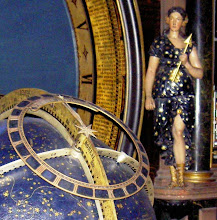 At this time of year the Earth and all who sail in her are apparently passing through the tail of a shattered comet. Any detritus near enough to us gets pulled towards the planet and burns its way through the atmosphere, offering us as it does so the Leonid Meteor Shower.
At this time of year the Earth and all who sail in her are apparently passing through the tail of a shattered comet. Any detritus near enough to us gets pulled towards the planet and burns its way through the atmosphere, offering us as it does so the Leonid Meteor Shower.And no it's not named after the old Soviet bloke with the eyebrows ("Thy name is immortal, thy deeds are unknown"), but after the constellation of Leo, where the shower appears to come from. So all you need to do is, find Leo. As luck would have it, Lunchista fille has a map: we bought it at Techniquest, the science exhibition in Cardiff (well worth a visit if you want some entertainment for anyone between the ages of 4 and 12). Here it is.
Leo spends some of its time near the sun, but that's in August so needn't bother us here in November. But it also spends a lot of its time below the horizon, including, when looked at from anywhere in Europe, the entire evening. This means the best time to see it, and the accompanying meteor show, is the wee small hours of the morning. The Planisphere in the shot is set up to show what you can see in the sky at 4 a.m. (GMT) tomorrow morning. Note the flash, which has obscured some of the "sky", is about where the sun would be at this time of year, making our shot even more realistic.
Leo's head looks a bit like a back-to-front question mark, and zooming in to our map shows Leo's head is in the Southeast, about halfway up from the horizon (the edge of the "window") to the zenith (the point where the straight and the curved red lines in the window cross). The dotted white line passes through all the signs of the zodiac and shows how the sun moves around it in a year: each dot is a day. The points of the compass look the wrong way round because you are holding the map over your head.
So the plan here at Chateau Lunchista is for all interested parties to get out of bed ludicrously early and either go up to the attic (from where, the two small Lunchistas assure me, stars can be seen) or failing that, to set out into the playing-field with our jim-jams covered in several extra layers.
It's funny to think that there's always a cloud of meteor debris lurking at this one particular spot that we pass through every November. Given that as we go around the sun, the sun itself is circling the middle of the galaxy, the debris must be following us around. It would always "see" us at the same time of year. Which brings Lunchista to an odd thought: supposing there were an alien spaceship parked about a month further along our orbit. Every time we passed by, we'd be celebrating Christmas. The aliens on board would form the impression that humans in this part of the world spent all the time in over-elaborate, too-brightly-lit places, either eating too much or getting into debt buying things nobody needs.
And of course they'd be completely wrong. Wouldn't they?

No comments:
Post a Comment